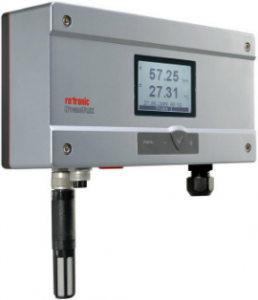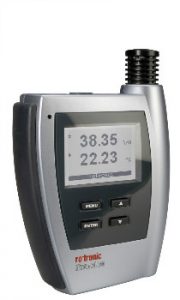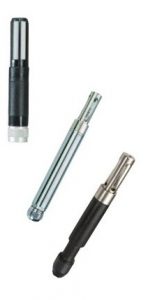Temperature and Humidity in Museums
Museums in General
A museum is an institution that cares for a collection of artifacts and other objects of scientific, artistic, cultural or historical importance and makes them available for public viewing through exhibits that may be permanent or temporary.
One of the main problems that a museum can face is to exhibit the artifacts in a way that no deterioration is caused by interaction with the surrounding environment!
The effective safekeeping of a museum collection is assured by providing the perfect environmental conditions protecting against the different agents of deterioration.
The Different Agents of Deterioration
Understanding how the environment affects a collection and how to monitor and control the different agents of deterioration is the most important part of a preventive conservation program.
 The major agents of deterioration would be:
The major agents of deterioration would be:
– Temperature
– Relative humidity
– Light
– Air pollution
We will focus here on both temperature and relative humidity.
Deterioration: is a natural process by which an object reaches a state of physical and chemical equilibrium with its immediate environment
Relative Humidity
Relative humidity will cause a chemical (structure change) or a physical deterioration to the object.
High Humidity:
– Will promote the chemical reactions as chemical reactions require water.
– Can encourage mold and other biological threats.
– Rust and other corrosion occur at high humidity levels.
Low Humidity:
– Can cause organics artifacts to crack.
– Embrittlement of fibers.
Fluctuating Humidity:
– Shrinking / swelling of unconstrained organic materials.
– Can crush or fracture con-strained organic materials.
– Could also cause for layered organic materials to delaminate
– Promote the loosening of joints.
Each artifact will need its own individual environment that corresponds exactly to its needs: to high and the artifact may hydrate, too low and the artifact will dehydrate.
Temperature
Temperature will cause a chemical (structure change) or a physical deterioration to the object.
High Temperature:
– Can cause gradual disintegration or discoloration of organic materials.
– Melting or softening of plastics, waxes and resins.
Low Humidity:
– Could cause dehumidifying of the artifact, resulting in fractures of paints, adhesives and other polymers…
Fluctuating Temperature:
– Fractures in solid materials can appear.
Exactly the same for the relative humidity, each artifact will need its own individual environment that corresponds exactly to its temperature requirements.
Why the need to measure relative humidity and temperature?
Relative Humidity:
All organic materials are hygroscopic and some inorganic materials too: so depending on the environment, some artifacts will absorb water and others will let off water.
Relative humidity will affect the following materials; examples of optimum ranges are also listed:
– Metal (<35%rh)
– Dyes (40…60%rh)
– Wood (45…60%rh)
– Ivory (45…60%rh)
– Paper (45…60%rh)
– Canvas (45…60%rh)
– Leather (45…60%rh)
– Paint (45…65%rh)
We would recommend that the fluctuations remain under ±5% rh.
Temperature:
Temperature is a measure of the motion of molecules in a material. If the temperature increases, the molecules speed up and spread out causing the material to expand. When the temperature decreases, the molecules slow down and come closer together causing the material to contract.
The recommended temperature would be around 20°C or lower if possible. The most important is that the temperature does not fluctuate.
Relative Humidity and Temperature:
Relative humidity and temperature are interrelated. Warmer air can hold more water vapor as the increase in temperature causes the air molecules to move faster and spread out, creating more space for more water molecules.
In a closed environment, if the temperature decreases, the relative humidity will raise and vice versa, if the temperature increases, the relative humidity will decrease. The absolute humidity will though remain exactly the same!
The Kelvin scale is an absolute, thermodynamic temperature scale using as its null point absolute zero, the temperature at which all thermal motion ceases (0 K is equal to -273.15°C)
What Solutions Can Rotronic Offer?
Rotronic can offer solutions in order to control monitor and calibrate humidity and temperature!
Rotronic has a range of products that also offer multiple solutions, like controlling and monitoring simultaneously, or monitoring and calibrating and even when desired/needed adjusting is possible!
On top of this Rotronic has products specifically made to be invisible, making installation easy without the need for an infrastructure!
The Rotronic HW4 software also offers the opportunity to see online exactly what is going on at any time. With the new group function it is also possible to upload a floor plan and see exactly where the measurement devices are placed.
Rotronic Products:
Humidity and Temperature Probes:
- HC2-S Standard humidity probe, -50…100°C, 0…100%rh, ±0.8%rh and ±0.1K…
- HC2-C04 or C05 Miniature humidity probe, -40…85°C, 0…100%rh, ±1.5%rh and ±0.3K, Ø 4mm or 5mm…
- HC2-IT/IP or IS Flush mount probes, -40…85°C, 0…100%rh, ±1.5%rh and ±0.2K…
Transmitters:
- HF5 series For interchangeable probes, 2 or 3/4 wire configuration, Various analog and digital outputs, Display, All psychrometic calculations available…
- HF8 series Two Interchangeable probes, 3/4 wire configuration, Various analog outputs, Relay and data logging, All psychrometic calculations, Display…
Dataloggers:
- HL-NT Range For interchangeable probes (up to 7 probes with docking station) 32MB flash card, Display, Conform to FDA21 CFR Part 11 and GAMP4…
- Wireless Range 500’000 measurement pairs, ±0.8%rh and ±0.1K, Radio frequency: 433.92 or 915Mhz, USB and LAN interfaces, Conform to FDA21 CFR Part 11 and GAMP4…
Customer Benefits:
Accuracy:
Choosing Rotronic gives you the best accuracy on the market.
Precise humidity measurements can be obtained: meaning that as soon as the required relative humidity level is reached, the dehumidifier can be switched off.
How is this better the maturing process?
The sooner the dehumidifier is switched off, the less power will be consumed.
Also in cooperation with the Rotronic HW4 software, it is possible to send an E-Mail or SMS to warn if the temperature or humidity is out of the specifications!
Communication:
With all of the different communication methods, from RS-485, Wireless to Ethernet RJ45, Rotronic can provide the solution for each installation.
Long term stability:
A long term stability with a drift under 1%rh per year (depending on the environment).
Calibration and adjustment:
Calibration and adjustment is very easy with the Rotronic product range. As all of the communication is digital, the whole calibration procedure can be done via a PC, or directly from the device with the help of the Rotronic humidity standards. Rotronic can also offer a factory calibration (certified or not).
Source: Rotronic
